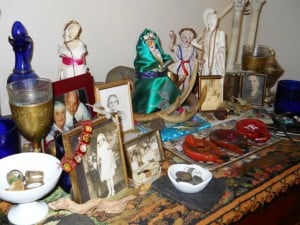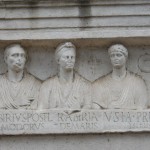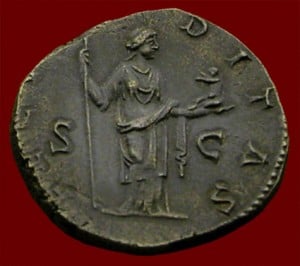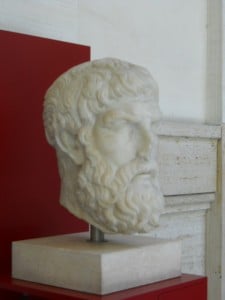Felicitas. Today begins the festival of Vestalia, which will last through 15 June. In ancient times it meant that the inner sanctum of the House of Vesta would be opened to the matrons of Rome. They were led by the Flamenica Dialis who was the wife of the high priest of Jupiter. Normally throughout the year she would be adorned in the manner of a bride, veiled and with a special hairstyle for marriage. But during this festival she would wear her hair down as though in mourning. She was not allowed to cut her hair or trim her nails at this time, nor would she have intercourse with her husband. I would assume the same was true of all the matrons who attended, because this festival was conducted as an annual cleaning of this edifice. Meanwhile, for other women, no marriages could take place. For us today Vestalia is a good place the begin examining the role of women in the religio Romana.
 Vesta is Goddess of the eternal divine fire. In the home She is represented by the hearth fire and in ancient Rome the fire maintained by the Vestal Virgins in Her temple was regarded as the most sacred place in the City as though it were the hearth of Rome. The House of Vesta was said to have been first founded by Numa Pompilius. While he was king, Numa performed the most important religious rites for the City, duties which were later turned over to the flamen Dialis and to the pontifex maximus. Historians have since considered the Vestal Virgins to represent the daughters of the king, while the Salii, or leaping priests of Mars, were thought to represent the king’s sons. The participation of all of the City’s matrons, led by the flamenica Dialis, would indicate that Vesta’s hearth, and Her temple, was connected to all of the homes of individual Romans and not just that of the king’s Regia. The welfare of the City, and the welfare of every Roman’s home, resided within the wives of Roman families – a point I shall return to at another time.
Vesta is Goddess of the eternal divine fire. In the home She is represented by the hearth fire and in ancient Rome the fire maintained by the Vestal Virgins in Her temple was regarded as the most sacred place in the City as though it were the hearth of Rome. The House of Vesta was said to have been first founded by Numa Pompilius. While he was king, Numa performed the most important religious rites for the City, duties which were later turned over to the flamen Dialis and to the pontifex maximus. Historians have since considered the Vestal Virgins to represent the daughters of the king, while the Salii, or leaping priests of Mars, were thought to represent the king’s sons. The participation of all of the City’s matrons, led by the flamenica Dialis, would indicate that Vesta’s hearth, and Her temple, was connected to all of the homes of individual Romans and not just that of the king’s Regia. The welfare of the City, and the welfare of every Roman’s home, resided within the wives of Roman families – a point I shall return to at another time.
It is interesting that even after the Romans first began to represent certain Gods and Goddesses, Vesta was represented only by a living fire for a thousand years. Inside Her edifice, however, there was an image that held special significance. It was said to have been very ancient, an image of Pallas, the lover of Minerva, made by the Goddess Herself. She had cast it down from the heavens as Her token of patronage for Ilus, the founder of Troy. When Troy fell to the Greeks, one of the Trojan nobles, Aeneas, was said to have escaped with a party of followers. He brought with him this image, the Palladium, as well as the Penates of Troy to a city he founded in Italy called Lavinium, which he had named after his Latin wife. Aeneas’ son founded the city of Alba Longa, and from his descendant Silvia Rhea, Mars then fathered Romulus and Remus. The Palladium thus would find its way to Rome. It was said that so long as it remained in Rome that the City would never fall. Such a precious relic, so important to the City’s welfare, was entrusted to the Vestal Virgins. No man was allowed to enter the House of Vesta, except for the pontifex maximus, and even he was not allowed to enter the inner sanctum to look upon the Palladium. But each year the matrons of the City entered that chamber to clean. There is a story, too, of one time when the House of Vesta caught fire and a pontifex maximus rushed in to save the Palladium. For his effort his life was spared, but Minerva blinded him as a reminder that no man might look upon the Palladium, let alone touch it. Not only the Palladium, but all of the most sacred relics of Rome were stored in the House of Vesta under the care of the Vestal Virgins.
Of all the sacerdotal colleges, sodalitates, and other priestly associations maintained by the Roman state, that of the Vestal Virgins was the only one that included women exclusively. There were other sacerdotal associations of women, not directly supported by the state, such as the sacerdotes of Liber, and there was at least one state sodalitas of both men and women who served as sacramental flute players. Certain priesthoods that were sponsored by the state were held by women in the temples of Rome, like the priestess of Ceres and likewise the Damia at the Temple of the Bona Dea. Women filled many sacerdotal roles, a fact that is often overlooked, but none so prominently as the Vestal Virgins. And no priests, male or female, were so entrusted with sanctity as were the Vestals, or so entrusted with everything held most sacred by the Romans as were the Vestals. Contrary to all the historical speculations about them, I think that the special role of the Vestals has more to do with the matrons who participated in Vestalia. Rather than look at all of the Vestals as daughters of Rex Numa Pompilius, we should instead see the Virgo Maxima serving as the matron, or domina, in the house of Vesta, with her charges serving under her as daughters of the house. That is, there is more to learn about the Vestals and their role in the state’s institutions by understanding the role of the domina in a Roman home. In the same way as other women act in their homes, the Vestal Virgins were believed to have special magical powers and also healing powers. And in the same way that women used their powers to transform a man’s house into a family temple, the Vestals may be seen to have transformed Rome from a common Latin city into something more.
First, the House of Vesta was called an aedes just just any other Roman house, from which we get our own term of edifice. It was never consecrated as a temple, as were the houses of other Gods and Goddesses at Rome. Nor had the space in which it sat ever been sanctified as a templum – the precinct in which a temple stood. However, the House of Vesta, and the house of the Vestal Virgins, as well as the house of the king called the Regia, the Temple of the Lares and some other important structures seem to make up what was once a religious complex. It was regarded as the center of the City’s pomerium, which was a sacred district encompassing six of the seven hills of Rome. It is this relationship of the sacred fire of Vesta, tended by Her Vestals at the center of Rome’s pomerium, that it places Her House as a hearth of the entire City of Rome. The Vestals attending to the hearth of Vesta is only one service that they performed, but an essential service that maintained the pomerium as a sacred district. It is only through maintaining that sacred space that Rome could benefit from the Pax Deorum that was believed to have made the Romans great. The Vestals, and really all of the matrons of Rome, were essential in preserving a contractual relationship between Rome and the Gods. Thus women in general, more than any male priesthood, was and ought to be the central element of the religio Romana. To understand why this is so we shall have to look more into the domestic religion and the role played by women in the Roman home, while understanding that what applied in the individual home transferred to the state religion rather than the other way around.















